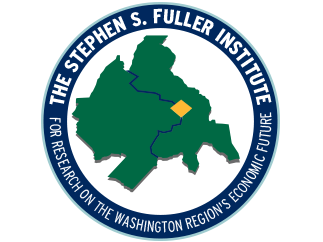Slow growth of the region’s knowledge-based and high-value added jobs could result in unrealized economic growth totaling $177.9 billion over next nine years.
Washington, D.C.—Today, Stephen Fuller, Ph.D., the Director of The Stephen S. Fuller Institute at the Schar School of Policy and Government at George Mason University, announced at the 25th Annual Economic Conference hosted by Cardinal Bank, the Northern Virginia Chamber of Commerce, George Mason University, and the Washington Business Journal, that the Washington region’s economy continues to struggle to pivot away from its historic dependence on federal spending. This is the conclusion of a new report issued by The Fuller Institute today: The Roadmap for the Washington Region’s Future Economy: Pivoting the Region’s Economy Away From Its Federal Dependence—An Assessment.
A year ago at this event, Fuller presented The Roadmap for the Washington Region’s Economic Future. The Roadmap, supported by the 2030 Group and a strong cross-sector coalition of regional organizations, identified seven advanced Industrial clusters in which the Washington region possessed a distinct competitive advantage in national markets. The growth of these clusters is not dependent upon the federal spending and they are export-based with high-value added jobs. Nationally, the jobs in these clusters are projected to experience above-average growth over the next decade and the Washington region is well positioned to benefit from this growth regionally to pivot away from its federally dependent economy.
While it may appear that the Washington region’s economy has recovered from the reduction in federal spending beginning in 2010, and the ensuing 2013 budget sequestration, Dr. Fuller warned regional leaders that looks may be deceiving. He noted that over the course of the past two years, job growth has been the strongest in more than a decade. However, these gains have been driven by jobs outside the region’s identified advanced industrial clusters, growth consisting largely of local serving jobs with lower average wages that lack the capacity to drive economic growth going forward.
“The key performance measure for the Washington region’s economy is not how many jobs it has added but whether the economy has been able to generate jobs of the quality needed to replace the federally dependent jobs that are no longer the source of the region’s annual economic growth,” said Fuller.
Although federal spending no longer constitutes as large a percentage of the region’s gross regional product (GRP) as it did at its peak in 2010, there is little evidence that Washington region’s economy has developed the capacity within its non-federally dependent, export-based, high-value added business base to replace the federal spending that has been lost and is no longer available to support the region’s future economic growth.
The GRP cost of growing the region’s advanced industrial clusters at their recent (2011-2014) historic rates to 2025 in comparison to growing these clusters at their full potential rates is the difference between the region’s economy growing at an annual rate of 1.83% and 2.56%. The GRP cost (foregone economic growth) of this slower growth rate in 2017 would be only $5.8 billion. But, each year that this differential growth rate continues, the annual value of foregone GRP increases. Over the full forecast period, 2016-2025, these annual GRP costs of under-performing their growth potentials would accumulate to a very significant cost; the Washington region’s economy would have generated $177.9 billion less growth (GRP) than could have been realized had only its advanced industrial clusters grown at their projected respective average national rates over this nine-year period.
“The longer we wait to pivot, the harder it will be for our regional economy to reach its potential or even to keep pace with our peer metropolitan regions,” said Fuller. “Breaking the region’s historic federal-spending dependence and pivoting to a private-sector driven, nationally and globally competitive economy, is not a natural process and will require targeted intervention, regional collaboration, and political leadership.”
To read the full report, click here.
To view the presentation, click here.
About The Stephen S. Fuller Institute
The Stephen S. Fuller Institute is the premier source for information and analysis of Greater Washington’s regional economy. The Institution provides local business, government leaders, and other stakeholders including the general public with a consistent analysis of the regional economy to ensure they are equipped with the information needed to make informed decisions regarding the future of Greater Washington. For more information and updates on The Stephen S. Fuller Institute, visit sfullerinstitute.gmu.edu.
Media Contact
Clare Flannery
(202) 365-7147
clare.flannery@deweysquare.com
